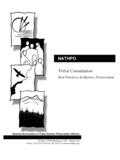Transcription of Tribal Domestic Violence Case Law June 11
1 Tribal Domestic Violence case Law Tribal Domestic Violence case Law Annotations for Selected Tribal Court Cases California Office: Minnesota Office: Montana Office: Santa Monica Blvd. Dayton Ave. N. Sanders St. Suite Suite Suite . West Hollywood, CA Saint Paul, MN Helena, MT 6 . ( )) - ( )) - ( 6)6) -8. -8 . Fax: (( )) - Fax: (( )) 66 - Fax: (( 6). 6) - . Tribal Court Clearinghouse: Tribal Domestic Violence . case LAW. Annotations for Selected Tribal Court Cases A Product of the Tribal Law and Policy Institute Last Updated: June 2011. This project was supported by Grant No 2004-WT-BX-K085, Grant No.
2 2006-MU-AX-K028 and Grant No. 2010-TA-AX-K002 awarded by the Office on Violence Against Women, Department of Justice. The opinions, findings, conclusions, and recommendations expressed in this publication are those of the authors and do not necessarily reflect the views of the Department of Justice, Office on Violence Against Women. 1 Primary Authors: Sarah Deer, Muscogee (Creek) Nation, Assistant Professor, William Mitchell College of Law Contributors: Jerry Gardner, Cherokee, Executive Director, Tribal Law and Policy Institute Carrie Garrow, St. Regis Mohawk, Executive Director, Center of Indigenous Law, Governance, and Citizenship, Syracuse University M.
3 Catherine OliverSmith, Student Research Assistant, UCLA. Heather Valdez Singleton, Deputy Director, Tribal Law and Policy Institute Abigail Wahl, Student Research Assistant, William Mitchell College of Law Diana Webster, White Earth Band of Ojibwe, Tribal Court Specialist, Tribal Law and Policy Institute Maureen L. White Eagle, M tis, Legal Consultant, Tribal Law and Policy Institute Editorial Assistant: Christine Dunn, Dunn Write Editorial 2 Violence AGAINST NATIVE WOMEN RESOURCES. COMMUNITY BASED LEGAL DEVELOPMENT. With support from the Office on Violence Against Women (OVW), the Tribal Law and Policy Institute (TLPI) has developed the following resources to assist Tribal governments in creating a comprehensive, community based, victim-centered response to Violence against Native women.
4 Each resource is designed to help your Tribal government customize laws and policies that fit your community's values, principles, and capacities. These resources are all freely available for downloading on the Tribal Court Clearinghouse ( ) except the textbook. Tribal Legal Code Resource: Domestic Violence Laws This guide for drafting or revising victim-centered Tribal laws against Domestic Violence is written with a philosophy that Tribal laws should reflect Tribal values. In addition, writing a Tribal law usually requires careful consideration of how state and/or federal laws might apply in the community.
5 This resource guide includes sample language and discussion questions which are designed to help Tribal community members decide on the best laws for their community. Listen to the Grandmothers Video and Video Discussion Guidebook This video and discussion guide is designed to assist Tribal programs with incorporating cultural traditions into contemporary responses to Violence against Native women. The "Listen to the Grandmothers video features Native elders speaking to the problem of Violence against Native women. The video provides a historical overview of Violence against Native women, traditional responses, and an analysis concerning the incorporation of cultural traditions into contemporary responses to Violence against women.
6 Sharing our Stories of Survival: Native Women Surviving Violence This textbook is a general introduction to the social and legal issues involved in acts of Violence against Native women, this book's contributors are lawyers, advocates, social workers, social scientists, writers, poets, and victims. In the Native women are more likely than women from any other group to suffer Violence , from rape and battery to more subtle forms of abuse, and Sharing Our Stories of Survival explores the causes and consequences of such behavior. The stories and case -studies presented here are often painful and raw, but a countervailing theme runs through the book: Many of the women who appear in these pages are survivors, often strengthened by their travails, and the Violence examined here is human Violence , meaning that it can be changed, if only with much effort and education.
7 This website is designed to provide Tribal and non- Tribal entities with information and resources pertaining to the issuance and enforcement of Tribal protection orders. Tribal Domestic Violence case Law: Annotations for Selected Cases This resource is designed to assist Tribal judicial officers in understanding how some Tribal governments have handled certain legal issues within the context of Domestic Violence cases. While a great deal of research has been done on case law in the state systems, little to no analysis has been done on the Tribal judicial approach to Domestic Violence . This compendium, developed as part of an overall code-writing workshop curriculum for Tribal governments, will assist Tribal legislators as well.
8 Understanding how laws are interpreted by the court systems may impact the development of laws that provide safety to Tribal citizens 3 Table of Contents HOW TO USE THE COMPENDIUM ..5. I. CIVIL A. CHILD CUSTODY ..6. B. DEFINITION OF Domestic ABUSE ..11. C. Tribal JURISDICTION AND POWER TO EXCLUDE ..13. D. TERMINATION OF PARENTAL RIGHTS ..16. E. VIOLATION OF A PROTECTION ORDER ..18. F. REMEDIES ..22. II. CRIMINAL ..24. A. ARREST ..24. B. CRIMINAL DEFINITION OF Domestic Violence ..27. C. DETENTION ..28. D. E. SELF-DEFENSE ..34. F. VERDICT ..36. G. SENTENCING ..37. 4 INTRODUCTION. This compendium is designed to assist Tribal judicial officers in understanding how some Tribal governments have handled certain legal issues within the context of Domestic Violence cases.
9 Although a great deal of research has been done on case law in the state systems, little to no analysis has been done on the Tribal judicial approach to Domestic Violence . This compendium, developed as part of an overall code-writing workshop curriculum for Tribal governments1, will assist Tribal legislators. Understanding how laws are interpreted by the court systems may impact the development of laws that provide safety to Tribal citizens. This compendium does not include every Tribal court opinion on Domestic Violence . It is limited to those Tribal court opinions that have been published and disseminated to the public, including cases found in the Indian Law Reporter (ILR), the Oklahoma Tribal Court Reports, and the Northwest Regional Appellate Court Reporter, and cases available on the Internet through the Tribal Court Clearinghouse2, a project of the Tribal Law and Policy Institute, as well as other Internet sources.
10 Tribal courts that do not publish opinions are not included in this compendium. HOW TO USE THE COMPENDIUM. The decisions listed in this compendium are not binding on any jurisdiction other than the one that issued the decision. Whether a particular Tribal court chooses to cite another Tribal court's opinion (as persuasive authority) is dependent upon a number of factors, including Tribal statutes, cultural similarities, and precedence. Citing any case outside the pertinent Tribal legal system should only be done after careful analysis of the relevance to and impact on sovereignty. Note: Domestic Violence is most often defined as intimate partner violence3, but many tribes define Domestic Violence much more broadly.







